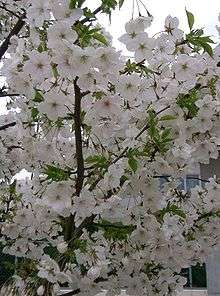Prunus speciosa
Prunus speciosa, the Oshima cherry, Japanese オオシマザクラ (Oshima zakura), is native to Izu Ōshima island and the Izu Peninsula on Honshū near Tokyo, Japan.[2][3]
| Prunus speciosa | |
|---|---|
 | |
| Scientific classification | |
| Kingdom: | Plantae |
| Clade: | Tracheophytes |
| Clade: | Angiosperms |
| Clade: | Eudicots |
| Clade: | Rosids |
| Order: | Rosales |
| Family: | Rosaceae |
| Genus: | Prunus |
| Subgenus: | Prunus subg. Cerasus |
| Section: | P. sect. Cerasus |
| Species: | P. speciosa |
| Binomial name | |
| Prunus speciosa (Koidz.) Ingram | |
| Synonyms[1] | |
|
List
| |
Description
Prunus speciosa is a deciduous tree typically 4–12 metres (13–39 ft) high. The leaves are 5–10 cm long and 3–6 cm broad, with a double-toothed margin, and an acuminate apex.
The flowers are 2.5–4 cm diameter, with five white petals, gold stamens and brown sepals; they grow in clusters in the spring, and are hermaphroditic. The fruit is a small black cherry about 1 cm diameter.[4][5][6]
A tree 8 m in circumference and 800 years old is known on Ōshima island. It has been designated a national treasure.[7]
 Prunus speciosa in the Jardin des Plantes of Paris April 2013.
Prunus speciosa in the Jardin des Plantes of Paris April 2013.- Prunus speciosa in the Jardin des Plantes of Paris April 2013.
 Prunus speciosa in the Jardin des Plantes de Paris April 2013.
Prunus speciosa in the Jardin des Plantes de Paris April 2013.
Cultivation
- Gardens
The Oshima cherry, is widely cultivated as an ornamental tree. Because of its large, showy flowers it is planted in many gardens and parks. There are many cultivars. It is also a hybrid parent of many of the sakura flowering cherry cultivars.[3] It prefers sun and moist draining soil.
- Food
The fruit is also edible. The flowers when dried are used to make tea. The leaves (sakura leaf or cherry leaf) are used in cooking and medicine to make 'cherry tree rice cake',[8] but P. speciosa is not the only sakura leaf.[9]
Classification
The plant was first described by Gen'ichi Koidzumi as Prunus jamasakura var. speciosa, and later treated as a separate species by Collingwood Ingram (1880-1981).[3] It is occasionally treated as a synonym of Prunus lannesiana.[10] or (particularly in Japan) as a variety of it, Prunus lannesiana var. speciosa (Koidz.) Makino.[8] The name speciosa in Latin means "the beautiful", a name which must apply to the blossoming tree.
See also
References
- "The Plant List: A Working List of All Plant Species". Retrieved January 27, 2014.
- "Prunus speciosa". Germplasm Resources Information Network (GRIN). Agricultural Research Service (ARS), United States Department of Agriculture (USDA). Retrieved 12 January 2018.
- Bean, W. J. (1980). Trees and Shrubs Hardy in the British Isles 8th ed., vol. 3. John Murray ISBN 0-7195-2427-X.
- Huxley, A., ed. (1992). New RHS Dictionary of Gardening. Macmillan ISBN 0-333-47494-5.
- Rushforth, K. (1999). Trees of Britain and Europe. Collins ISBN 0-00-220013-9.
- More D., & White, J. (2002). The Illustrated Encyclopedia of Trees p. 545. Timber press, Portland, Oregon ISBN 0-88192-520-9.
- Taafe, G., & Levy-Yamamori R. (2004). Garden Plants of Japan p. 197. Timber press, Portland, Oregon ISBN 0-88192-650-7.
- Tree pictorial book by Kanon: Prunus lannesiana var. speciosa (in Japanese) Google translation
- http://www.efloras.org/florataxon.aspx?flora_id=1&taxon_id=250100403
- Plants for a Future Database: Prunus lannesiana
External links
| Wikispecies has information related to Prunus speciosa |
| Wikimedia Commons has media related to Prunus speciosa. |